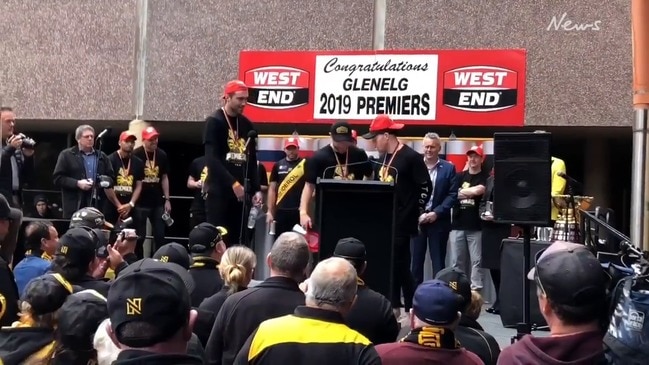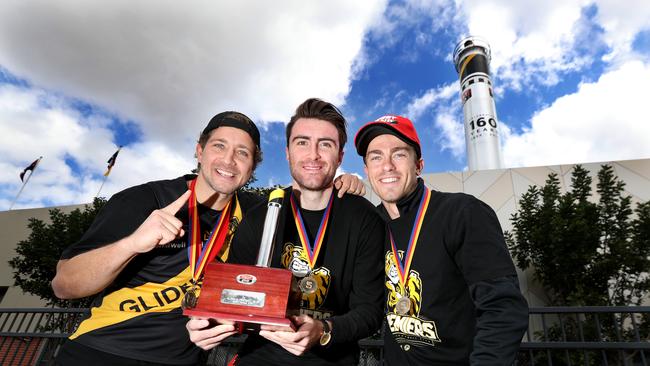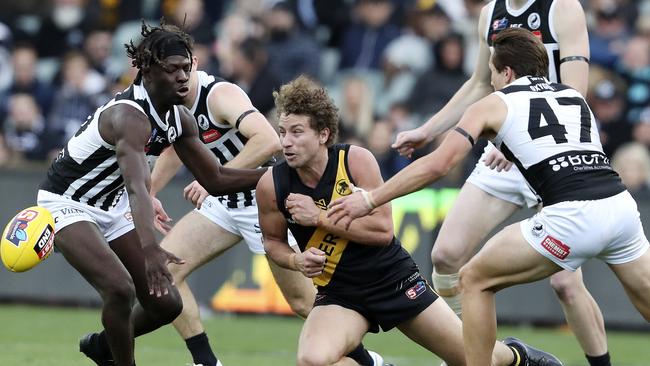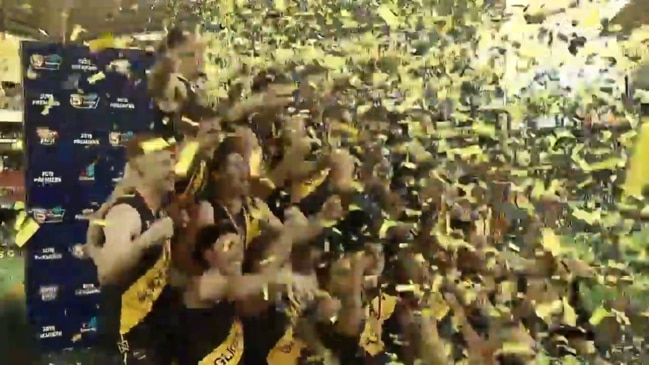Graham Cornes: Glenelg broke premiership drought, but football was the winner
Gillon McLachlan and Steve Hocking should have paid a visit to last weekend’s SANFL grand final. They might have returned home with a new respect for real football, writes Graham Cornes.

Graham Cornes
Don't miss out on the headlines from Graham Cornes. Followed categories will be added to My News.
- Russell: AFL set to lay down law to SANFL
- Prizes, discounts, freebies: Check out the latest subscriber rewards
AT a time when the AFL threatens to overshadow all other football competitions and completely engulf them, the SANFL grand final restored our faith in local footy.
In the past three seasons our local grand finals have been fantastic spectacles.
The quality of football on display in those matches has vindicated the fierce, at times belligerent, independence the SANFL has displayed since then president Max Basheer withstood the incursions of the VFL raiders in the late ’80s.
Ultimately Basheer, Leigh Whicker and the other members of the South Australian Football Commission were sabotaged by treachery from within but the determination to maintain an independent SANFL has prevailed through subsequent generations of football administrators in this state.
Stream over 50 sports live and on demand with KAYO SPORTS. Just $25/month, no lock-in contract. Get your 14-day free trial and start streaming instantly >

It’s not easy. The AFL and its media partners consume most of the broadcasting space. The AFL’s own media department is bigger than our local television stations and produces content that swamps local media outlets and local news. But still we prevail.
The highest AFL officials were invited to our SANFL grand final last week. None attended – a further indication of their disrespect.
Had they done so they would have seen how vital SANFL footy is to our state and how we must fight tooth and nail to protect and preserve it.
The AFL regards the state competitions with such disdain it has even introduced a mid-season draft that rips the best players out of local teams and disrupts the clubs’ seasons.
Of course the players relish another opportunity to fulfil their AFL dream but if they are good enough and the recruiting officers are doing their job properly, an end-of-season draft and a rookie draft should be enough to fill any AFL list.
He’s waited 33 years for this. @Cornesy12 💛🖤 #SANFL pic.twitter.com/avjF7e80bn
— Kane Cornes (@kanecornes) September 22, 2019
The fact John Noble, who started the season with West Adelaide, realised a dream of finals football with Collingwood and Marlion Pickett, from South Fremantle, will make his debut for Richmond in Saturday’s grand final, does not vindicate the AFL’s selfishness.
The AFL treats the SANFL and WAFL with a contempt that reinforces the perception our competitions simply do not matter and are merely feeder competitions.
However, the outstanding attendances of 39,000 plus at our past three SANFL grand finals indicate otherwise.
More people attended those three grand finals than most Power home games. That at least should alert AFL footy chiefs we have something significant to offer here and maybe they could learn something. Instead they are clamouring for us to change our local rules and conform to the new AFL laws which impacted this season.
Some of them, such as the starting positions and the play on from a kick-off, the SANFL have already adopted but the AFL is not happy we’ve rejected a couple of the others.
They are very keen for the SANFL to replace our 25m penalty for minor infractions after a mark or a free kick with the 50m penalty.
SANFL must stand firm on this one. The 50m penalty as it is summarily and inconsistently applied in the AFL is a draconian, game-changing punishment for infractions that are so minor they would probably go unnoticed.
The AFL also wants the SANFL to abandon its last touch out-of-bounds free kick if a kick or handball goes out without being touched. It wasn’t a popular law when it was introduced in the SANFL, mainly because it did change the look of our traditional game and put defenders under a lot more pressure as they attempted to clear the ball. But the statistics don’t lie. There are less stoppages and higher scores in the SANFL since it has been adopted.

Additionally it is a much fairer law than the AFL’s deliberate out-of-bounds rule which is inconsistently and randomly applied, much to the anger of the fans.
The other law the SANFL employs to increase scoring and enhance the “look” of the game is to cap the rotations from the bench to 60, which is 30 per cent lower than the AFL’s.
Still, the SANFL has many challenges, not the least of which is accommodating the reserves teams of the Crows and Power in its competition.
Steve Hocking, the AFL’s chief of football, maintains the presence of the AFL reserves teams enhances the local competition. On the contrary, it corrupts it. Instead of the promised increased crowds in the minor round games, attendances have fallen. This is particularly so in the Crows’ reserves games. Port Adelaide has played in two of the past three SANFL grand finals. Fortunately it lost both those games but it is only a matter of time before it wins one. It will be a dark day for South Australian football.
Besides, last year’s classic between North Adelaide and Norwood proved you don’t need Port Adelaide in a grand final to get a big crowd.
The inequity of full-time, highly-paid professionals playing in the same competition as part-time footballers continues to frustrate local fans and administrators. The irony of that is the AFL wants the state competitions to restrict their salary caps even further. There is no easy answer. The AFL has scrapped any plan for a national reserves competition so we are stuck with the two AFL reserves teams and their differing agendas.

After the grand final triumphs, the biggest challenge the SANFL has now is to maintain and improve attendances at its minor round games. There are at least two solutions to this. One is to make the local games more appealing to kids. The future of the SANFL rests with those youngsters. One of the most obvious highlights of the grand final was the colour in the crowd and how many kids were there in club colours. The Glenelg Football Club had record sales of merchandise.
Much of it was children’s guernseys, beanies, caps and hoodies. Most of those youngsters followed the Bays simply because their parents did.
It’s the same at most clubs and it must be a SANFL priority to get more of them to local home games. Control of anti-social crowd behaviour and more activities for the youngsters will be a good start. Continuing promotion in local schools is a must. The other solution is scheduling SANFL games so they don’t clash with Crows or Power AFL games, which so often happened this season.
Glenelg broke a 33-year drought to win last week’s SANFL grand final.
The emotion of it all was both surprising and overwhelming. I saw it last year among the North Adelaide supporters – despite the controversy that preceded it – and the year before among Sturt supporters.
Gillon McLachlan and Steve Hocking should have been here to witness it.
They might then have retreated back to their Docklands headquarters with a new respect for real football.
